Green Infrastructure in the Semi-Arid West
Low-Impact Development and Green Infrastructure in the Semi-Arid West
On this page:
- Introduction
- Green Roofs
- Rain Gardens
- Bioswales/Bioretention Cells
- Detention/Retention Ponds
- Porous Pavements
- Rainwater Harvesting
- Contact Information
Introduction
Low impact development (LID) is a method of building design and community development with the intention of keeping storm water runoff as uncontaminated as possible. “Slow it down, spread it out, soak it in” is the motto of LID. Slowing the flow of stormwater reduces erosion and flooding dangers. Spreading stormwater out reduces the speed of the stormwater. Allowing the stormwater to soak into the ground recharges underground aquifers and fosters environmental growth. Green infrastructure (GI) is a method of water management that is as sustainable, environmentally friendly, and cost-effective as possible. GI focuses on creating ecosystems to treat polluted stormwater runoff prior to it entering aquifers, streams, or other waterways. On-site management of stormwater is the first choice, with neighborhood or regional solutions the next preferable solutions.
When LID and GI are implemented in a semi-arid climate, attention must be paid to our unique environment. With a dry climate and large temperature differences between summer and winter, native plants that are drought tolerant and low maintenance must be chosen that can withstand the harshness of our region.
Green infrastructure in the semi-arid West can be specifically designed to address rapid freeze/thaw cycles, semi-arid conditions, and intermittent and unpredictable rainfall patterns.
Green Roofs
In Region 8 most “Green Roofs” are not actually the color green. To represent this, many green roofs in our region are referred to as “living roofs” or “eco-roofs”. Green roofs reduce the volume of storm water runoff and filter the storm water runoff that does leave the roof.
Unique Benefits
- Green roofs create a place for stormwater to soak in, reducing the amount of stormwater runoff from a building. The foliage also slows and filters the stormwater that does runoff the roof
- When built in urban areas, green roofs can reduce the Urban Heat Island Effect which is dangerous to human health, especially at our higher elevations. Having enough green roofs in a city can actually reduce the energy expenses of surrounding buildings as the urban temperatures are reduced
- Region 8 experiences very warm summers and very cold winters. Green roofs reduce energy expenses for buildings by providing insulation to reduce heat loss during the winter and air-conditioned loss during the summer
- Due to our increased elevation from sea level, buildings in Region 8 are exposed to intense solar radiation, which damages the roof membrane. Green roofs extend roof lifespan by protecting the membrane from sun damage
- Green roofs can provide habitat for birds, butterflies, insects, etc.
Examples
Fargo, ND: Hotel Donaldson’s Sky Prairie on The Roof restaurant allows guests to enjoy the view from the roof and the garden on it as well. The vegetation is mostly on the outer edge of the roof, proving a roof does not need to be completely covered in foliage to reap the benefits of having a green roof.
Denver, CO: The REI parking garage turns a traditionally gray area into a green island in the city. This green roof reduces the Urban Heat Island Effect and creates a large area for stormwater to absorb into a garden. It also provides an attractive open space near the South Platte River.

Salt Lake City, UT: Church of Jesus Christ of Latter-Day Saints (LDS) Conference Center takes advantage of their large roof to provide a fountain and walking garden for visitors to enjoy. The gardens also reduce the amount of runoff from the conference center.

Laramie, WY: Robert and Carol Berry Biodiversity Conservation Center creates a classroom on the roof for children and students to learn about native Wyoming plants. This green roof is an ongoing experiment, testing over 60 native drought tolerant plants to see their potential for green roofs within our region. Updates about the native plants can be seen on the Berry Prairie blog.
Denver, CO: The first publicly accessible green roof in Denver is on the roof of the Denver Botanic Gardens. The plants used are native to our region, testing their potential for use on green roofs.

Denver, CO: The EPA Region 8 building contains a green roof of sedums in trays for easy irrigation. The roof also provides insulation to the building, reducing heating and cooling costs. Experiments have been done on the roof with the solar panels and the sedums. The vegetation keeps the solar panels cool and the solar panels provide shade for the plants.

Helena, MT: The Montana State Fund building harvests rainwater to irrigate the vegetation on the roof. The building is LEED certified Gold because of its many green innovations.

Jackson Hole, WY: Jackson Hole and Greater Yellowstone Visitor Center sod roof.

Denver, CO: The former Denver Museum of Contemporary Art uses their green roof as an art exhibit as well as a vegetated area. Most of the plants are native to Colorado and only require watering a few months of the year.

Recommended Sites
- Design Guidelines and Maintenance Manual for Green Roofs in the Semi-Arid and Arid West.pdf (pdf)
- EPA Region 8 Green Roof
- Denver Botanic Gardens Research Project
- Green Roofs
Rain Gardens
Positioned near paved surfaces or lawns, rain gardens consist of native plants that catch runoff.
Unique Benefits
- Reduce the stormwater runoff entering streams and ponds by catching the water in the gardens. The runoff that does enter the natural water sources is filtered by the plants in the garden.
- In arid and semi-arid regions like ours, native plants are drought resistant and hearty. Thus they require little to no maintenance once they are installed.
- When used in public areas they can provide shade and aesthetic benefits.
- Rain gardens can meet public landscaping requirements as well as provide stormwater benefits.
Examples
Boulder, CO Western Resource Advocates, 2260 Baseline Rd: Including a rain garden in a parking lot design provides storm water runoff control and a source of shade for cars parked in the lot. The rain garden allows the water to soak into the ground while watering plants. See cuts in the concrete to allow stormwater flow.

Denver, CO: Property near Regis University uses rain gardens for the collection of stormwater. The native grasses both slow and filter the water.

Fargo, ND: Microsoft uses porous pavement in their parking lot and rain gardens surrounding the lot to essentially eliminate all runoff. This combination of LID and GI results in the stormwater being cleaner when it enters the aquifer.
Fort Collins, CO: New Belgium Brewery takes advantage of a rain garden’s aesthetic qualities while also using it for runoff control. The rocks and plants in the garden create an area for the stormwater to slowly absorb and be filtered.

Cheyenne, WY: Antiques Central used a Nonpoint Source Pollution Control grant from the State and EPA to create rain gardens surrounding their building. Water running off of the roof of the building can be absorbed into the gardens, reducing the distance the stormwater travels, and thus improves its quality.

Denver, CO: The Denver Housing Authority uses both rain gardens and pervious pavements in their Park Avenue development. This helps the new development to be environmentally friendly as well as attractive. DHA was able to decrease stormwater infrastructure costs from $850,000 (stormwater vault) to $350,000 (bioswales and permeable pavements) at its Park Avenue site. DHA estimates that they will save $3,000,000 at its Mariposa site by using low-impact development/green infrastructure over traditional grey infrastructure (see link for stormwater/gi design charette).

Salt Lake City, UT: As a part of their Sustainable Campus Initiative the University of Utah built rain gardens to capture and filter stormwater runoff. The garden also has educational purposes as well.

Denver, CO: The TAXI Development uses rain gardens to filter water from their parking lots before it reaches the storm drain. The garden also features native plants and requires limited additional water. Note: there are several pictures:

Denver, CO: Central Park (Stapleton) soft running path and green infrastructure in street median.

Boulder, Colo.: Rainwater is collected in a planter box then is channeled into a rain garden. The water is collected from the gutters on the roof of the Environmental Center of the Rockies. 2 pictures.
Denver, CO: Former 1035 Cherokee, side yard where two areas are passively irrigated by storm water runoff from roof downspouts, this was a former driveway to the parking area.

Recommended Sites
Bioswales/Bioretention Cells
To filter contaminants from stormwater runoff, many communities in Region 8 choose to install bioswales, sloped drainage areas that contain vegetation. Most bioswales continue for several miles, often running next to roads or walking paths. The slope of the bioswale allows the water to drain slowly, thus increasing its filtering time. The native vegetation in the bioswale removes pollutants as the water drains. Soil preparation and soil type are key to infiltrating water effectively.
Unique Benefits
- Since bioswales are long and often run alongside of the road they do not take up large amounts of space and can be used in urban, suburban, or rural settings.
- The vegetation in a bioswale filters the stormwater runoff and provides an attractive vegetated area.
Examples
Denver, CO: Central Park (formerly Stapleton) Quebec Square shopping center. Bioswale between a parking lot and a road.
Fort Carson, CO: Vegetative swale

Fort Carson, CO: Iris in Bioretention Pond
Denver, CO: Central Park (formerly Stapleton) Greenway Park during a storm event.

Denver, CO: Central Park (formerly Stapleton) Greenway Park during the fall.

Denver, CO: Northfield at (Central Park (formerly Stapleton) with Interstate 70 in the background.

Denver, CO: Westerly Creek at Central Park (formerly Stapleton). Daylighted creek that was under taxiways at Stapleton International Airport. Westerly Creek is now part of open space and has a functioning floodplain and wetlands.
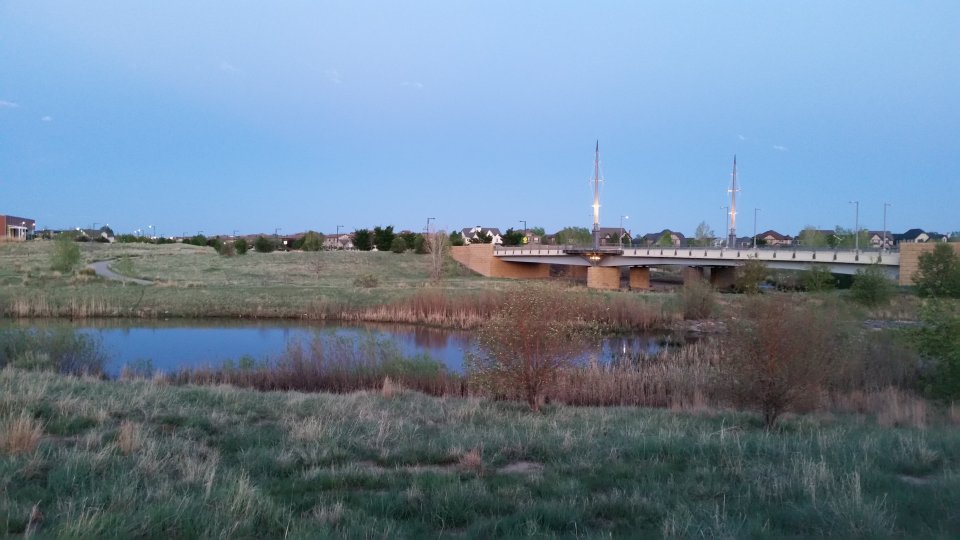
Denver, CO: The South Platte River near downtown. The vegetation can be inundated in large flow events.

Denver CO: Streetside stormwater planters (bioretention cells) and stone gabian wall benches along Brighton Blvd. in the River North (RINO) area near Interstate 70.
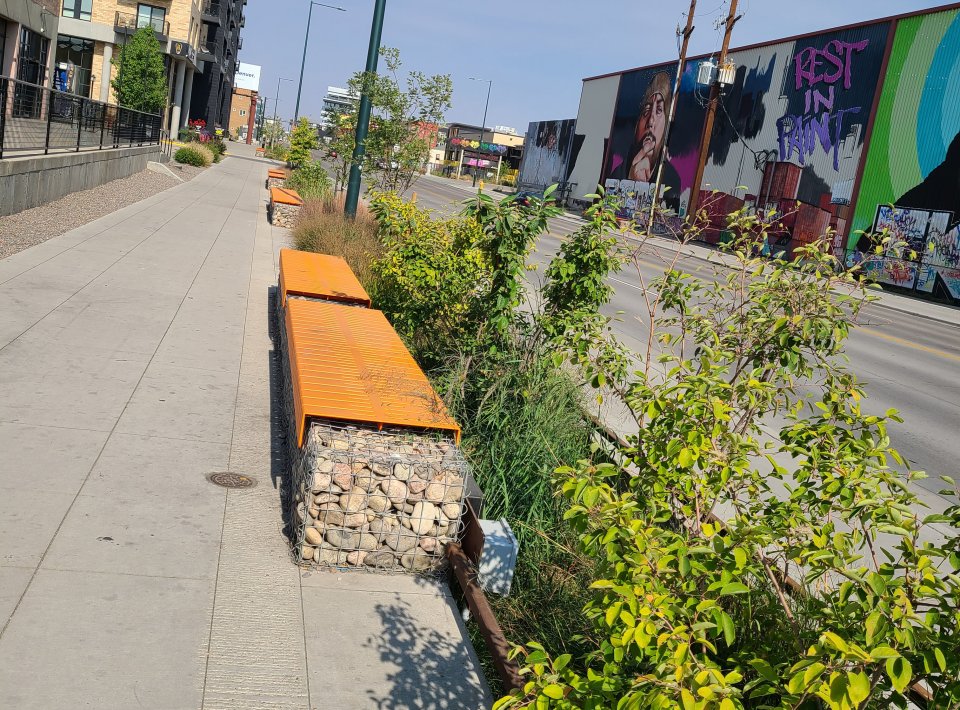
Golden, CO: Constructed wetlands and stone gabian walls adjacent to parking garage at the National Renewable Energy Lab.
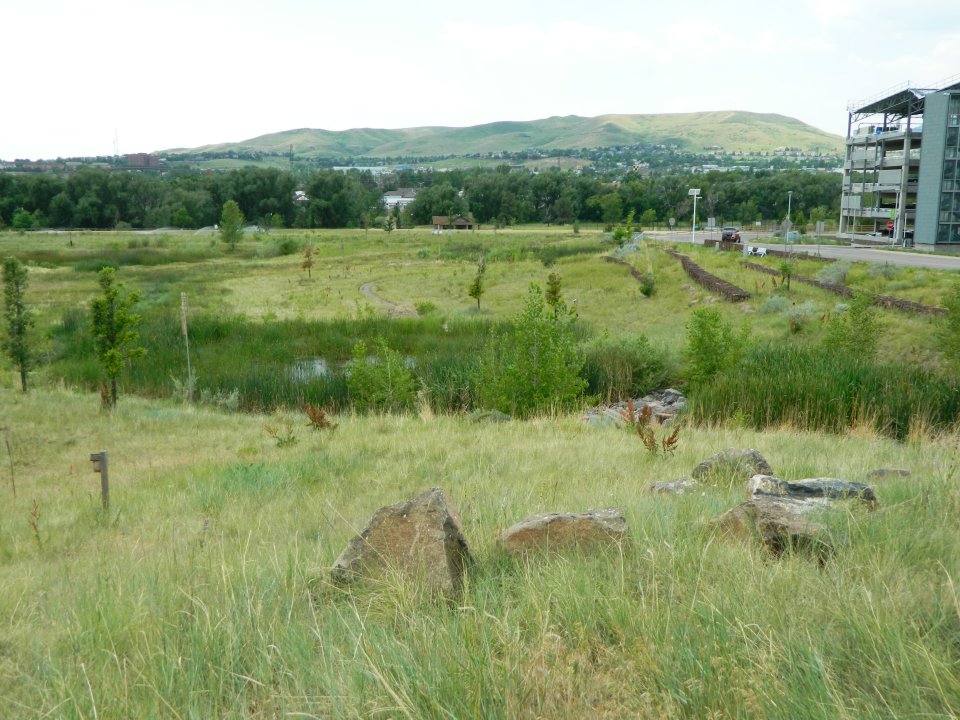
Resources
- Green Infrastructure Toolbox Biofiltration Swale (pdf)
- Green Infrastructure Toolbox Bioretention (pdf)
- Green Infrastructure Toolbox Bioretention PIC (pdf)
Detention/Retention Ponds
In Region 8 flash floods are often a concern, as sudden rainfall releases large amounts of water quickly. Detention and retention ponds create a location for this rainwater to collect and infiltrate into the aquifer. During times of no rainfall the detention pond stays dry while a retention pond contains a constant amount of water.
Unique Benefits
- Prevents flooding by creating a storage space for the large amounts of water provided from hard, sudden rainfall.
- During dry seasons provides an open space for many animals and plants to thrive.
- In the snowy winter months acts as a storage place for piles of snow that have been removed from sidewalks and parking lots.
Examples
Fargo, N.D.: The Woodhaven neighborhood has a large stormwater retention pond that collects stormwater runoff. The retention pond provides a large area for stormwater to spread out and drain into an underground aquifer slowly, filtering the water in the process.

Denver, CO: City Park contains several retention ponds where water levels are constant during most of the year, then rise during wet seasons. These retention ponds reduce erosion to the park and create a wetland ecosystem.
Denver, CO: A shopping center uses a retention pond to collect and filter stormwater runoff before it enters the underground aquifer. The plants surrounding the retention pond filter the water as it drains, allowing cleaner water to enter the aquifer.
Porous Pavements
Speeding stormwater runoff and fast floods are concerns in Region 8 states. Porous pavement absorbs stormwater runoff instead of increasing its speed.
Unique Benefits
- Replenish aquifers with water that is filtered by the pavement as it drains.
- In Region 8 we have a great risk for flash flood when there is a large storm. Porous pavements can reduce flooding risks by slowing storm water runoff, making communities safer.
- Many types of porous pavements are unaffected by routine freezing and thawing cycles that are seen in the winters in Region 8, allowing them to be more durable than traditional nonporous concrete. Porous pavements, just like traditional asphalt and concrete, can be adapted for all types of climates.
Examples
Sioux Falls, S.D.: To prevent flooding of their office, Woodlawn Cemetery installed pervious pavement. Their office hasn’t flooded since! The water absorbs into the pavement, is filtered, and enters the underground aquifer instead of flooding and causing erosion to the surrounding area.

Rapid City, S.D.: Camp Rapid, home of the South Dakota National Guard, uses porous pavement to absorb stormwater runoff and snowmelt from the visitor parking lot. The water can absorb through the pavement.

Fort Collins, CO: Odell Brewery uses pavers and a flow through parking island planter to slow the flow of stormwater. The parking islands provide a location for the water to collect, have the contaminants removed by the plants and rocks, and then slowly absorb into the aquifer.

Billings, MT: The Northern Plains Resource Council Building utilizes porous pavement made of recycled materials to reduce runoff. This reduction in runoff allows the quality of water entering to the aquifer to be much higher and for the risk of flooding to be reduced.

Rapid City, S.D.: Western Dakota Tech uses pervious pavements on visitor paths to filter stormwater, allowing the water to absorb into the pavement instead of rushing off and collecting pollutants.

Fort Collins, CO: CTL Thompson created a driveway of pervious pavement.
Denver, CO: Path along the South Platte River near downtown

Fort Collins, CO: Permeable paver parking spaces drain to a rain garden at a local park.
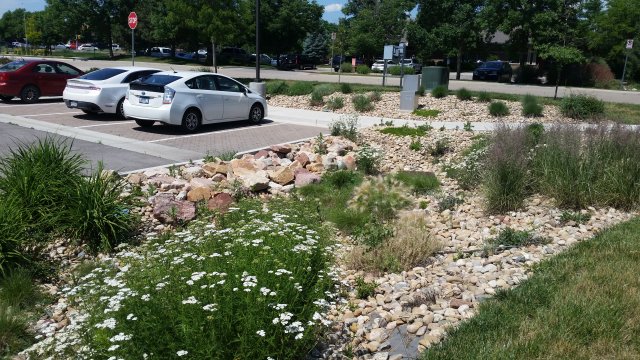
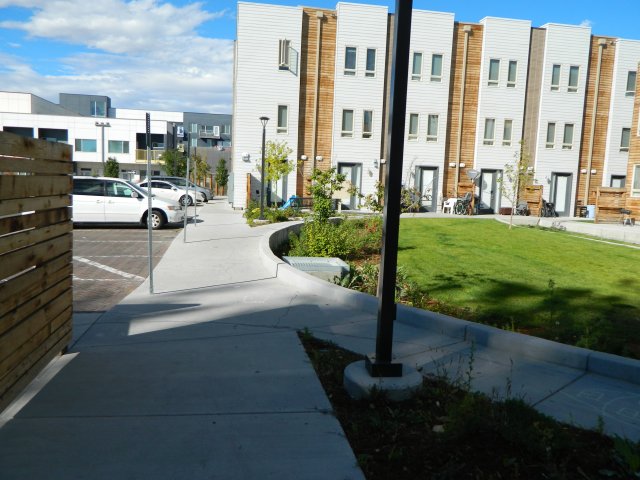
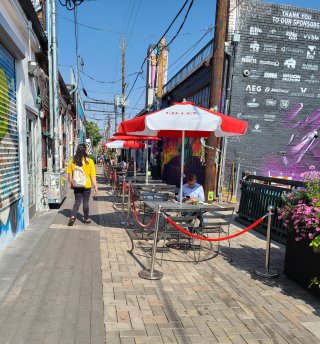
Recommended Sites
Rainwater Harvesting
Easy to do, rainwater harvesting allows residents to collect non-potable water and use it for various household purposes such as watering plants and mopping floors. Note that rainwater laws differ in the Region 8 states.
| Colorado | Montana | North Dakota | South Dakota | Utah | Wyoming | |
|---|---|---|---|---|---|---|
| Responsible Agency | Colorado Division of Water Resources | Montana Department of National Resources | North Dakota Water Commission, State Engineer | South Dakota Department of Natural Resources | Utah State Engineer | Wyoming State Engineer and Board of Control |
| Permit Required | Situational; See Below | No | No | Situational; See Below | Situational; See Below | Situational; See Below |
| REGULATORY REFERENCES | CO Surface Water Rainwater Collection | Montana Licenses & Permits | North Dakota Century Code | South Dakota Water Right Permit | Utah Enacted Rainwater Harvesting SB 32 (pdf) Utah Code 73-3-1.5 (pdf) |
Wyoming State Surface Water Division Wyoming Water Law Summary |
Unique Benefits
- Reduces water bills by using the non-potable rainwater to water plants and for other household uses.
- Allows more water to be available for downstream use as less treated water is withdrawn from locations upstream.
Recommended Sites
- Online Rainwater Harvesting Community
- Rainwater Harvesting Tool for Water Supply Availability in Colorado
- Green Infrastructure Toolbox Rainwater Harvesting (pdf)
Further Reading on GI/LID
- Natural Resources Defense Council Rooftops to Rivers II (pdf)
- River Keepers
- Low Impact Development Center
- Community Flood Recovery with Green Infrastructure (pdf)
- Trees Have Unexpected Impacts on Water Use in Northern Colorado
Resources for Financing GI Projects
- Clean Water State Revolving Fund: Green Project Reserve
- Green Infrastructure Incentive Mechanisms (pdf)
- Green Infrastructure Funding Options
Regionally Specific Scoping and Design Guidance for GI
- Green Roof Species Selection and Growing Medium Mixes for Colorado (pdf)
- Oklahoma State LID Website
- Montana Watercourse
- North Dakota Rural Water Systems Association
- Green Infrastructure in Arid and Semi-Arid Climates (pdf)
- Ultra-Urban Green Infrastructure
- Stormwater Center Colorado State University
- Planning for flood Hazards in Colorado
- Evaluation of Green Roof Plants and Materials for Semi-Arid Climates
- MHFD Urban Stormwater Criteria
- Colorado Resiliency Framework
- Green Infrastructure for SW Neighborhoods (pdf)
- Arid LID Coalition
- Best Management Practices for Stormwater Management in the Desert Southwest
Regional Case Studies and Example GI Projects
- Greening America's Capitals - Pierre, SD
- Greening America's Capitals - Helena, MT
- Greening Valley City, ND (pdf)
- Sun Valley Stormwater (pdf)
- Denver CO Options for Green Infrastructure (pdf)
- South Platte Natural Capital Project
- City of Fort Collins, CO LID
- Denver Green Roof Map
- Green Roof Plants Denver Botanic Gardens
- Rainwater Harvesting in Denver
- Green Infrastructure in Missoula, MT Story Map
- Reconnecting the Wasatch Front with Green Infrastructure (pdf)
- Denver Green Infrastructure Story Map
- Denver Urban Field Station
- Metro Denver Nature Alliance
Webinars
- Green Infrastructure for Resilient Cities-Poudre RiverFest July 15, 2021
- Addressing Stormwater Management through Community Driven Green Infrastructure Design April 28, 2021, EPA Southeast New England Program Webinar
- CO Stormwater Symposium September 2, 2020
- Green Infrastructure: A Triple Bottom Line Approach to Environmental Justice, Webinar May 19, 2019
- Outdoor Water Use and Green Infrastructure June 6, 2018 EPA WaterSense Webinar
- Water Conservation and Catchment: Green Infrastructure in the Semi-Arid West
- AWE/EPA WaterSense Outdoor Webinar - Landscape Transformation Case Studies (pdf)
- AWE/EPA WaterSense Outdoor Webinar - The Nexus Between Water Efficiency and Stormwater
Contact Information
Stacey Eriksen ([email protected])
Urban Watershed Revitalization Coordinator & Green Infrastructure Coordinator
303-312-6692
Amy Clark ([email protected])
Environmental Scientist
303-312-7014
